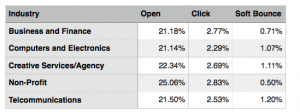
B2B Articles - August 19, 2016
This might sound like a SNL ad parody, but email overload is real. The average person, in fact, has an average of 1.9 accounts, accounts that are more immediately accessible with technology advances in connectivity and smartphone devices. Email marketing needs to be relevant to the buyers’ needs and appropriate to their buying lifecycle stage

By the end of 2019, the number of worldwide email users will increase to over 2.9 billion, according to the Radicati Group’s Email Statistics Report 2015-19. With over one-third of the world using email by 2019, it’s important for the email marketer to keep up with email marketing best practices to improve their open, clickthrough and lead generation tactics.
Effective Email Marketing Strategies
With over 205 billion emails sent and received each day, it’s difficult for email marketing — even the most powerful — to get seen.
While a good email is concise, there are a couple of encyclopedias worth of text out there offering strategies to improve email marketing stats. A succinct summary of the highlights suggests:
Monitoring the Results
The job does not end when the email is sent out, though. It’s important too to track the success of the emails. That’s where metrics come into play. Consider these MailChimp findings as of July 5, 2016, identifying average unique opens, unique clicks and bounces across several industries:

This condensed chart alone illustrates the importance of understanding data in context. Only by comparing benchmarks from other brand campaigns and others in the industry can the email marketer improve their efforts.
Key metrics to track include:
Of course these are only a general guideline. What email metrics you actively benchmark may vary depending on the campaign objective. If you’re trying to generate new contacts email share and forwarding will have more value. Whereas if you are a non-profit looking to increase donations the conversion rate in a fundraising campaign would likely be more valuable.
Some other statistics to think about?
Sources
eConsultancy. (2015). Conversion Rate Optimization Report 2015. https://assets.econsultancy.com/documents/0001/1094/SAMPLE-Econsultancy-Conversion-Rate-Optimization-Report-2015.pdf
Kolowich, L. (2016, Feb. 18). Email Analytics: The 6 Email Marketing Metrics & KPIs You Should Be Tracking. https://blog.hubspot.com/marketing/metrics-email-marketers-should-be-tracking
Kolowich, L. (2016, June 21). 19 Simple Email Marketing Tips to Improve Your Email Open and Clickthrough Rates. https://blog.hubspot.com/marketing/make-emails-more-clickable-list
MailChimp Research. (n.d.). Email Marketing Benchmarks. https://mailchimp.com/resources/research/email-marketing-benchmarks/
M+R. (2016). Benchmarks 2016. https://mrbenchmarks.com/
Radicati Group. (2015 March). Email Statistics Report, 2015-2019.
https://www.radicati.com/wp/wp-content/uploads/2015/02/Email-Statistics-Report-2015-2019-Executive-Summary.pdf
Slutz, J. (2015, November 12). 5 automated emails smart marketers send. https://myemma.com/content-hub#ufh-i-155948853-5-automated-emails-smart-marketers-send
Van Meter, M. (2016, June 15). 7 habits of highly effective email marketers. https://content.myemma.com/h/i/264500241-7-habits-of-highly-effective-email-marketers

Tel 212-993-7809
Ironpaper ®
10 East 33rd Street
6th Floor
New York, NY 10016
Map
New York Agency
B2B marketing
B2B Content
Demand generation agency
Digital Marketing
Account-Based Marketing
ABM for SaaS
ABM for energy
Demand generation campaigns
Industry marketing
Privacy Policy
First-party data marketing
SaaS marketing
SEO for B2B
IoT Marketing
B2B Marketing for IoT Companies
HubSpot Agency
B2B Product Marketing
B2B Software Marketing
IoT go-to-market strategy
IT Marketing
HubSpot for ABM
ABM for AI companies
Technology Marketing
Marketing for IT Companies
ABM Campaigns
B2B lead generation
B2B Marketing and Growth Agency.
Grow your B2B business boldly. Ironpaper is a B2B marketing agency. We build growth engines for marketing and sales success. We drive demand generation campaigns, ABM programs, B2B content, sales enablement, qualified leads, and B2B marketing efforts.